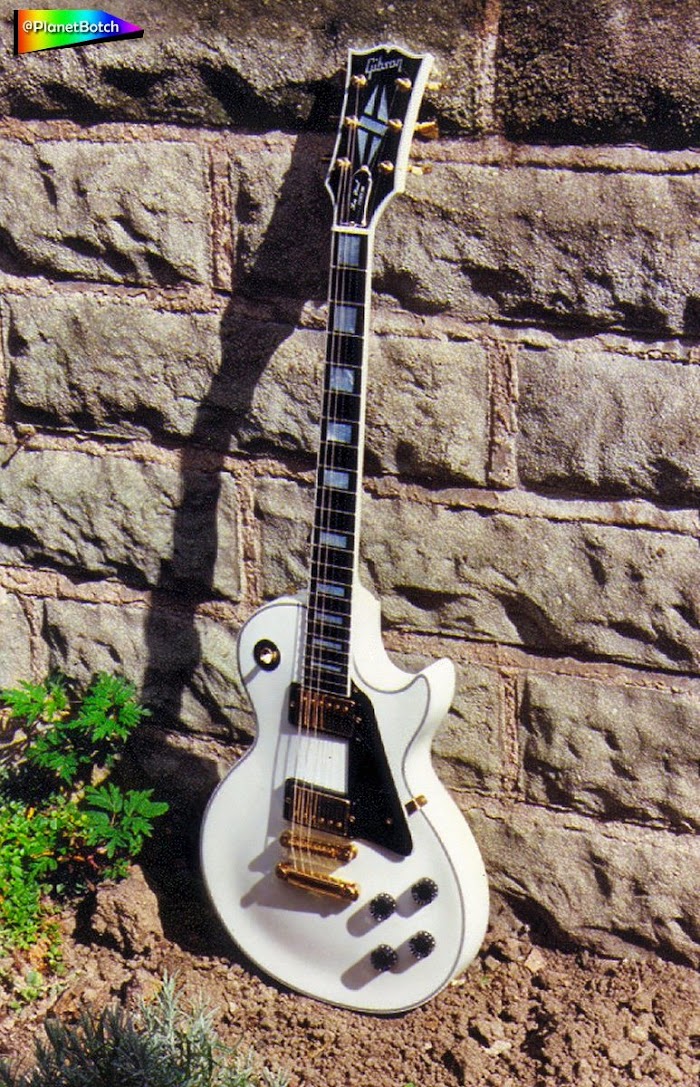
Through the latter part of the 1980s I vowed that I’d never buy a Gibson Les Paul. I’d borrowed a Tokai Love Rock (Les Paul copy) for a short time in 1988 but hadn’t really thought a great deal of it. Fender guitars were my thing, and I was blowed if I was forking out for a secondhand Gibson when I could basically buy two Fenders for the same price – or even perhaps a nice old Jazzmaster or Jaguar from the mid 1960s.
However, in 1990, economic conditions were such that for a short time it became possible to get brand new Les Pauls for unusually low prices in the UK. Much as I’d resolved never to entertain the idea of buying a Les, it was very hard not to consider it when the brand new models were priced virtually the same as the secondhand ones. The opportunity prompted me to read up on what the Les Paul offered for the money. Before I knew it, there I was, in the guitar shop on a Saturday afternoon (23rd June to be precise), plugging a brand new, alpine white Gibson Les Paul Custom into an amp.
£850, brand new, in a Gibson hard case, really was a remarkable deal for a Les Paul Custom in mid 1990. Even taking into account over twenty-one years of inflation, that’s still more than £1,000 cheaper than the best deals I can find on new Les Paul Customs today. So, what did you actually get for the money?
If guitars were purely ornaments, a white Les Paul Custom would be difficult to rival. The finish on this guitar was spectacular, with a beautiful, natural and definitely in no way plasticky gloss. Gibson finishes instantly make me think of craftspeople, traditional methods, and a work ethic centred around pride. The rich, natural gloss, the luxurious purfling around the wood, the gold plating on the metal parts, the awesome quality of build… it all added up to something you felt highly privileged to own. Even my parents were impressed with it, and I can assure you that was never the case if I revealed to them that I’d spent a similar amount on a weathered 1960s Fender!
But guitars are not purely ornaments, obviously. They're musical instruments, and must be evaluated primarily on that basis. So, diehard Les Paul fans brace yourself, and here goes...
Les Pauls, as I see them, are prone to ‘taking over’ and dictating to some extent what the player should be doing. They’re sustain machines, built with such thickness, weight and density of wood that it’s hard to use them in any subtle fashion. This example added higher output and rather hollow-sounding pickups to all that mahogany, creating an output which was, in my view, quite ill-defined and overwhelming.
Put it through a Marshall stack at high gain and you could churn out hard rock riffs and solos without even trying. But that was it really. This definitely wasn’t a versatile guitar. I suppose I could have changed the pickups for something more biting (like PAF types) or with greater personality, but I think I knew the instrument was gonna end up back on the market, so I didn’t want to risk devaluing it.
Sadly, it didn’t work out between me and this aesthetically stunning but musically one-dimensional artefact. After an initial phase of using it to record rock-orientated tracks, I got bored with the slabs of rather compressed and dynamically-limited sound. I even ended up re-recording some of the Les Paul’s parts in a number of songs with a Strat. When that moment arrived, I knew my relationship with this particular Les Paul was over.
Interestingly, I’ve since bought two other Les Pauls (one a Gibson, one a Japanese Fernandes), and I love them both. The Gibson is a ‘tiger top’ LP Classic with Seymour Duncan pickups, and the Fernandes is a ‘gold top’ with single coils. Toppier, standard-output pickups do help a Les Paul greatly, I feel, and I wonder what would have been the outcome had Gibson fitted PAF-style units to my LP Custom in 1990? Traditionally, Les Paul Customs have differed from Standards in their wood construction, with Standards featuring maple tops on mahogany slab bodies, and LP Custom bodies composed entirely of mahogany. This is another factor I believe can 'dull down' the tone of a Custom and give it less definition.
Fortunately, I never took the LP Custom out to use at gigs, and I kept it in pristine condition, so when prices rose again, I was able to sell it without difficulty, and without losing out. Do I regret selling it? Well, it’s hard to sum up how stunning a Custom looks and feels when you first take it out of its case. It even smells good! But as a player rather than a collector, I’m always going to want guitars I can use. Guitars I can use to record tracks, which end up signposting my life and giving the instrument some context other than sitting on a stand looking pretty. On this basis, I don’t think the Custom would ever have been a keeper, but I say that purely through personal taste. The build, production standard and finish of this guitar was beyond reproach, but the sound and personality didn't suit me. Fascinating experience owning such a high-end guitar though, and Saturday 23rd June 1990 is certainly a day I'll always remember with great fondness.
More Guitar Reviews and Retrospectives

